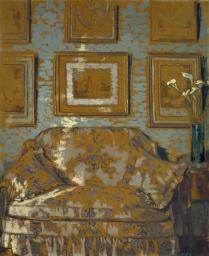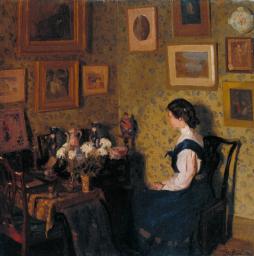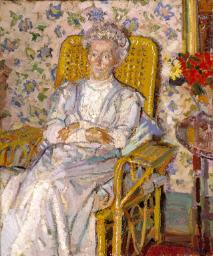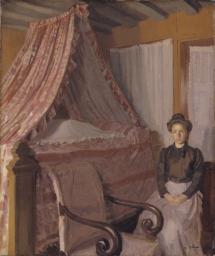Harold Gilman Lady on a Sofa c.1910
Harold Gilman,
Lady on a Sofa
c.1910
The painter’s sister Irene is the subject of this domestic scene, lying on a sofa with open book in hand, possibly asleep. The figure is strongly delineated by her dark brown dress and hair in contrast to the light decorative furnishings surrounding her.
Harold Gilman 1876–1919
Lady on a Sofa
c.1910
Oil paint on canvas
305 x 405 mm
Inscribed by the artist ‘Gilman’ bottom right
Purchased (Benson Fund) 1948
N05831
c.1910
Oil paint on canvas
305 x 405 mm
Inscribed by the artist ‘Gilman’ bottom right
Purchased (Benson Fund) 1948
N05831
Ownership history
Judge William Evans (1861–1944) by 1911; Hugh Blaker (1873–1936) by 1928; bought at Leicester Galleries, London, by Tate Gallery 1948.
Exhibition history
1910
Modern Pictures by the New English Art Club, Royal Society of British Artists Galleries, London, Summer 1910 (256).
1911
?The First Exhibition of the Camden Town Group, Carfax Gallery, London, June 1911 (54, as ‘The Sofa’).
1928
Contemporary British Art, Whitechapel Art Gallery, London, October–December 1928 (166).
1929
The Hugh Blaker Collection, Platt Hall, Rusholme, Manchester, May–June 1929 (65).
1929
The Hugh Blaker Collection of Oil Paintings, Watercolours, Drawings etc., Public Art Galleries, Brighton, September–October 1929 (10).
1948
Selected Paintings, Drawings and Sculpture from the Hugh Blaker Collection, Leicester Galleries, London, March 1948 (89).
1954–5
Harold Gilman 1876–1919, (Arts Council tour), Arts Council, London, January–December 1954, Manchester Art Gallery, November–December 1954, Tate Gallery, London, May–June 1955 (16, as ‘Woman on a Sofa’).
1976
Camden Town Recalled, Fine Art Society, London, October–November 1976, Graves Art Gallery, Sheffield, November–December 1976 (26).
2002
Harold Gilman and William Ratcliffe, Southampton City Art Gallery, April–July 2002 (no number).
2008
Modern Painters: The Camden Town Group, Tate Britain, London, February–May 2008 (39, reproduced).
References
1964
Mary Chamot, Dennis Farr and Martin Butlin, Tate Gallery Catalogues: The Modern British Paintings, Drawings and Sculpture, vol.1, London 1964, p.237.
1979
Wendy Baron, The Camden Town Group, London 1979, p.226 no.81, reproduced p.82.
2000
Wendy Baron, Perfect Moderns: A History of the Camden Town Group, Aldershot and Vermont 2000, pp.167, 169.
Technique and condition
Lady on a Sofa is painted in artists’ oil paints on a primed, stretched canvas. The cloth is fine plain weave linen with some rough and uneven threads whose texture is visible at the surface. The cloth is probably sized but this is not detectable and one layer of white primer has been evenly applied. The priming extends to the cut edges on all but one side. Primer has penetrated through to the back of the canvas in places, indicating that if present the sizing is very thin and does not form a continuous layer. The stretched support is similar to all of the works by Gilman that have been examined (see also Tate T00096).
There is no visible evidence of initial drawing. The main composition was established in broadly brushed dark blues and greys, which are visible at the edges of forms. The painting appears to have been carried out over a period of time. Thick paint has been worked across the surface using small-headed brushes, building up a lively texture through variation in application. Gilman has worked both wet-in-wet, mixing colours on the surface, and wet-on-dry allowing touch-dry colour to remain undisturbed by the application of more paint. He has reworked and modified some areas several times, for example, the rug and the valance and arms of the sofa. The effect is of a moving play of light and dark across the surface with final impasto accents of bright colour drawing the painting together.
There is a clear transition in technique in this painting moving from his early fluency to the rigorous patterning of his later works. In 1910 Gilman described a new modern technique of painting; the ideas outlined are explored through his own practice in Lady on a Sofa:
the juxtaposition of small pieces of paint of the moderns is a new technique. In this way one can work from light to dark (setting the light as high as its colours will allow), or from dark to light, all over a painting at one go or labouring at part only of the canvas. One can work upon dry paint without oiling out, correct without niggling, labour without paint.1
Roy Perry
August 2001
Sarah Morgan
August 2004
Notes
How to cite
Roy Perry and Sarah Morgan, 'Technique and Condition', August 2004, in Robert Upstone, ‘Lady on a Sofa c.1910 by Harold Gilman’, catalogue entry, May 2009, in Helena Bonett, Ysanne Holt, Jennifer Mundy (eds.), The Camden Town Group in Context, Tate Research Publication, May 2012, https://wwwEntry
The sitter for Lady on a Sofa was Gilman’s sister Irene Beatrice Gilman (1877–1944). Her daughter Betty Powell (born 1916) recalls that Irene told her the circumstances of the picture being made.1 Irene sat frequently for her brother, often in tiring poses, of which an example must be Tate’s Edwardian Interior (Tate T00096). This time she insisted on a more relaxed position, although lying for long periods on the sofa apparently turned out to be almost as tiring. The oblique angle of the book would make it impossible to read, and either Irene has tired of it or has actually fallen asleep. Gilman was renowned for the slow and careful pace at which he worked. Powell remembers the sofa being part of their household furniture. It was of the type that had two folding arms and, unlike in the picture, her mother would usually lie on it with either one or both arms folded down. The picture was painted in Preston, probably at their parents’ first house after their marriage.
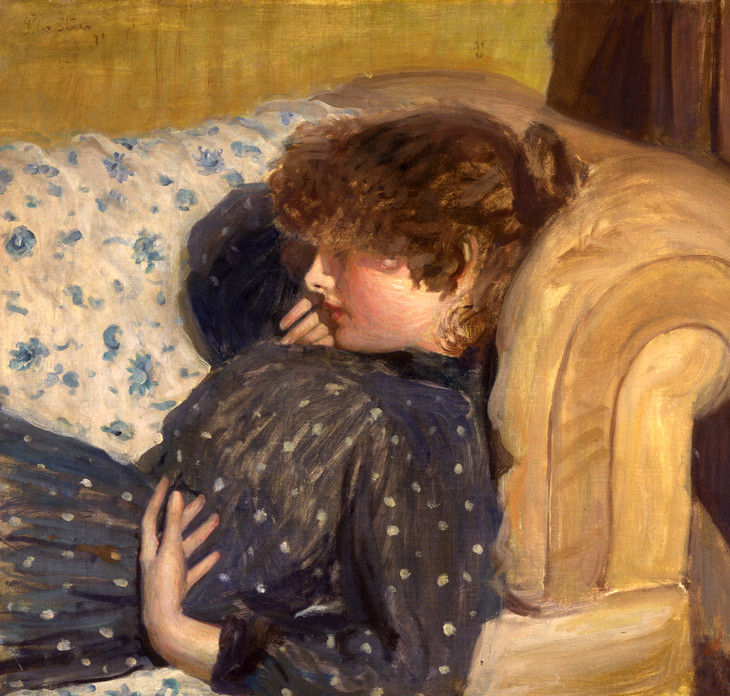
Philip Wilson Steer 1860–1942
Girl on a Sofa 1891
Oil paint on canvas
563 x 613 mm
Colchester and Ipswich Museum Service
© Estate of Philip Wilson Steer
Photo © Colchester and Ipswich Museum Service
Fig.1
Philip Wilson Steer
Girl on a Sofa 1891
Colchester and Ipswich Museum Service
© Estate of Philip Wilson Steer
Photo © Colchester and Ipswich Museum Service
The picture’s first owner was Judge William Evans, a keen collector of Camden Town Group paintings (see Tate N05099). Gilman painted another picture of Irene on the same sofa, Lady on a Sofa (private collection),3 which once belonged to Edward Le Bas. This shows only the top half of Irene’s body. It is likely that one of these was exhibited by Gilman at the first Camden Town Group exhibition in 1911, but it is not possible to ascertain which with certainty.
Robert Upstone
May 2009
Notes
Related biographies
Related essays
Related catalogue entries
Related reviews and articles
- Harold Gilman, ‘The Venus of Velasquez’ The Art News, 28 April 1910, p.198.
How to cite
Robert Upstone, ‘Lady on a Sofa c.1910 by Harold Gilman’, catalogue entry, May 2009, in Helena Bonett, Ysanne Holt, Jennifer Mundy (eds.), The Camden Town Group in Context, Tate Research Publication, May 2012, https://www



